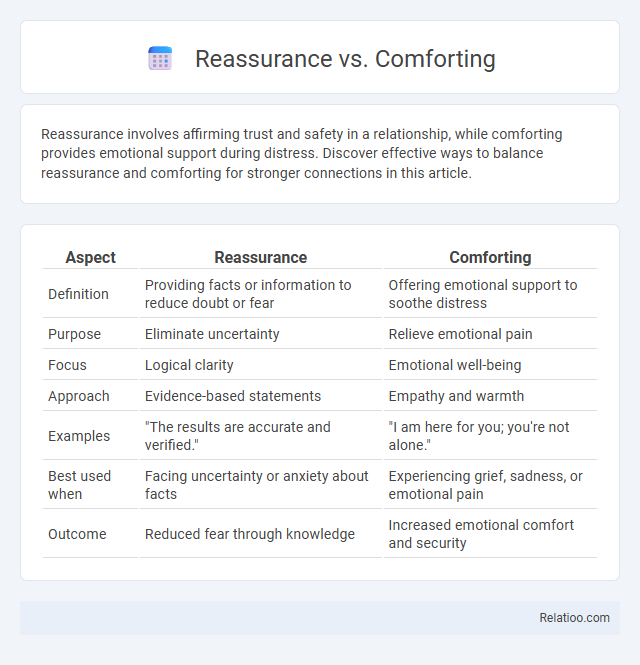Reassurance involves affirming trust and safety in a relationship, while comforting provides emotional support during distress. Discover effective ways to balance reassurance and comforting for stronger connections in this article.
Table of Comparison
| Aspect | Reassurance | Comforting |
|---|---|---|
| Definition | Providing facts or information to reduce doubt or fear | Offering emotional support to soothe distress |
| Purpose | Eliminate uncertainty | Relieve emotional pain |
| Focus | Logical clarity | Emotional well-being |
| Approach | Evidence-based statements | Empathy and warmth |
| Examples | "The results are accurate and verified." | "I am here for you; you're not alone." |
| Best used when | Facing uncertainty or anxiety about facts | Experiencing grief, sadness, or emotional pain |
| Outcome | Reduced fear through knowledge | Increased emotional comfort and security |
Understanding Reassurance and Comforting
Understanding reassurance involves providing factual information or validation to ease doubts or fears, while comforting focuses on soothing emotions through empathy and warm gestures. Reassurance appeals to the logical mind by addressing specific concerns, whereas comforting nurtures emotional well-being by fostering a sense of safety and support. Your ability to differentiate between these approaches enhances effective communication and emotional intelligence.
Key Differences Between Reassurance and Comforting
Reassurance involves providing factual information or affirmations to reduce anxiety by addressing specific concerns, while comforting focuses on offering emotional support to soothe feelings of distress or sadness. Your choice between reassurance and comforting depends on whether the person needs clarity and confidence or empathetic presence and warmth. Understanding these key differences helps tailor your response effectively to emotional or cognitive needs.
The Psychology Behind Reassurance
The psychology behind reassurance involves providing clear, consistent information to reduce anxiety and build a sense of safety, which activates the brain's calming mechanisms. Unlike comforting, which focuses on emotional support and empathy, reassurance targets cognitive reassurance, helping Your rational mind counter fear and uncertainty. This process strengthens trust and confidence, essential for long-term emotional resilience and well-being.
The Emotional Impact of Comforting
Comforting has a profound emotional impact by providing immediate relief from distress through physical presence, soothing tone, and empathetic gestures, which create a sense of safety and validation. Unlike reassurance, which aims to reduce uncertainty with logical explanations or promises, comforting directly addresses emotional pain and fosters connection. This empathetic engagement enhances emotional resilience and supports mental well-being during moments of vulnerability.
When to Use Reassurance vs Comforting
Reassurance involves providing factual information or affirmations to reduce anxiety and boost confidence, while comforting focuses on offering emotional support and empathy during distress. You should use reassurance when someone seeks clarity or certainty about a situation, and comfort when the primary need is emotional consolation or understanding. Balancing these approaches helps effectively address both the rational and emotional aspects of someone's concerns.
Common Situations Requiring Comfort or Reassurance
Common situations requiring comfort or reassurance include moments of anxiety, grief, or uncertainty, where individuals seek emotional support to stabilize their feelings. Comforting often involves empathetic presence and soothing words to alleviate distress, while reassurance provides factual or verbal affirmations to reduce fear or doubt. Both methods play crucial roles in mental health contexts, such as coping with loss, facing medical procedures, or managing workplace stress.
Benefits and Drawbacks of Reassurance
Reassurance provides immediate relief by affirming safety or correctness, helping to reduce anxiety and uncertainty in stressful situations. However, overreliance on reassurance can foster dependence, preventing individuals from developing self-confidence and coping skills. Comforting offers emotional support through empathy and warmth, which strengthens bonds but may not address underlying fears as directly as reassurance does.
How Comforting Shapes Emotional Resilience
Comforting provides a tangible response that soothes immediate distress and fosters a sense of safety, which is crucial for building emotional resilience over time. Unlike reassurance, which often involves logical affirmation to alleviate doubts, comforting directly engages empathy and presence, helping Your emotional brain regulate stress more effectively. Understanding these distinctions enhances Your ability to support others in ways that strengthen long-term mental well-being and coping skills.
Effective Communication: Combining Reassurance and Comfort
Effective communication integrates reassurance and comforting to address both emotional and cognitive needs in stressful situations. Reassurance involves providing clear, factual information that alleviates uncertainty and builds confidence, while comforting offers emotional support through empathy and soothing language. Combining these strategies enhances trust, reduces anxiety, and fosters a supportive environment for meaningful dialogue and problem resolution.
Practical Tips for Offering Support
Offering support effectively requires distinguishing between reassurance, comforting, and validation to address emotional needs accurately. Reassurance involves providing factual information to alleviate doubts, comforting focuses on expressing empathy and warmth, while validation acknowledges and accepts feelings without judgment. You can enhance your support by actively listening, using clear affirmations, and aligning your response to the individual's current emotional state for greater impact.

Infographic: Reassurance vs Comforting
 relatioo.com
relatioo.com